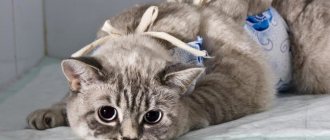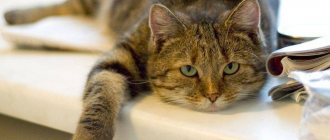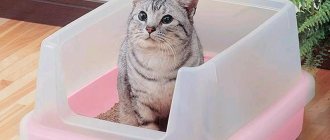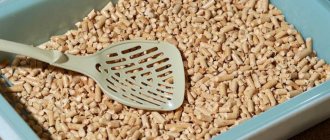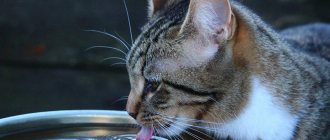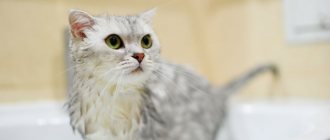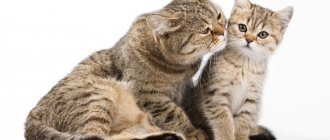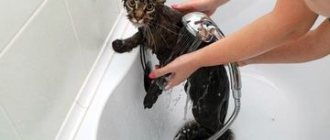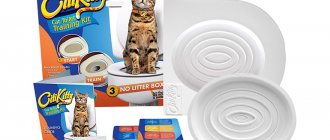How much water should a cat drink per day?
The average moisture requirement of mammals is about 5% of their live weight. This includes drinking water and taken with food. If there is neither one nor the other, body reserves are consumed: with the oxidation of 100 g of fat, an average of 106 g of water is formed. In hot weather the animal drinks more, in cool weather less.
If your cat is sick, water intake may decrease or increase. Therefore, you should not panic. If the cat does not lap up the water, then perhaps she is getting enough moisture from the food.
How can this problem be solved?
First we need to discuss water quality. Cats will always prefer fresh, clean water to stagnant or cloudy water. Therefore, the water should be changed daily or even several times a day - it will only be better.
We must not forget that the water in the bowl can become contaminated not only from dust or the ingress of some foreign objects, but also from cat saliva, which gets there in sufficient quantities after the first drink.
If a dog lives in the house with a cat, then it will probably drink from the same bowl, which can also affect the cat’s attitude towards such water. In this case, you should block the dog's access to the cat's drinking bowl. For example, a bowl can be placed on a windowsill.
One of the unsuccessful options for a water container is a double bowl into which both food and water are poured. In bowls with a similar device, food particles often fall into the water, contaminating it. The same thing happens when the water bowl is too close to the food bowl. Also, you should not use the same bowl for eating and drinking; in other words, the drinking bowl must be a separate container.
Care should be taken to ensure that the water does not contain any impurities and does not have any repulsive odors. Perhaps you should refrain from using various detergents and cleaning products, since they leave odors that the cat will not necessarily like. Although it can be argued that she will not like them for sure.
Reasons why a cat doesn't drink water
All the reasons why a cat does not lap from a bowl are divided into physiological and pathological.
Physiological reasons
The cat does not lap from the bowl for the following reasons:
- Eating natural food or wet canned food. In the wild, there is enough water in the body of a mouse or bird. In the savannah, during the dry season, predators eat meat that contains enough moisture, and if hunting does not bring luck. They use up their own fat reserves.
- The bowl of water smells unpleasant. Instinct does not allow a cat to drink bad water. If the drinker is located next to a tray or feeder, it takes on the smell of excrement or fermented food. In the wild, it is not dirty water that poses a danger to a cat, but microscopic algae that multiply in it and release algatoxins.
- The cat doesn't like the bowl. Metal utensils rattle, plastic utensils absorb odors. Therefore, it is necessary to use ceramic or glass bowls.
Be sure to read:
The cat has a stuffy nose: reasons, how to treat it, is it possible to use nasal drops, what will happen if the runny nose is not treated
Pathological causes
Diseases that cause vomiting, swelling, inflammation of the mouth, paralysis, are accompanied by a refusal to drink. The cat doesn't drink not because he doesn't want to, but because he can't.
The gag reflex applies to everything that enters the stomach: food and water. This condition is called hydrophobia and hydrophobia. Associations with rabies should not be made.
There are many pathological conditions in which a cat refuses to drink. The most dangerous are panleukopenia or calcivirosis. But such diseases are typical for unvaccinated kittens and are distinguished by many other pathological symptoms.
How to determine if your cat drinks enough fluid per day
Animals have the same problems as humans when they don't get enough fluids. Cats may not get the moisture they need for a variety of reasons, but owners should closely monitor their pet's health.
Be sure to read:
How to reconcile cats living in the same apartment: several ways to make pets friends
The following signs may indicate your pet's condition:
- Skin elasticity . Your pet's skin becomes dry and stiff if he doesn't drink enough fluids. Normal dermis quickly regains its shape if you grab the cat's scruff and pull.
- Condition of the coat. It is worth sounding the alarm when the cat’s fur loses its shine and begins to fall out. If the animal does not have parasites or allergies to the selected diet, then the problem may lie precisely in the lack of moisture. When a pet's coat is shiny, it makes it clear that its health is not in danger.
- Physical activity. Without the necessary moisture, the cat becomes inactive, reacts sluggishly to calls, and does not want to play.
- Frequency of urination . If an animal urinates less than 2 times a day, this is a sign of ill health.
The cat does not drink water, what should I do?
If the cat stops drinking from the bowl, it is necessary to assess his condition and analyze his diet. If the cat is given mushy natural food or wet canned food, enough moisture is supplied. However, some owners believe that the cat must drink and to do this they open the water tap or purchase a drinking fountain. Other felinologists consider tap water unsuitable for pets and purchase bottled water.
If the cat does not lap up water, then it is necessary to monitor its behavior. When a pet is depressed, its eyes are sunken, its fur is disheveled, its skin is flabby, it is necessary to force it to drink. You can draw water into a syringe without a needle and pour it into the mouth drop by drop. The animal may not like it.
Then they resort to an alternative option: saline or Ringer-Locke solution is injected under the skin. The latter remedy is preferable because it contains Potassium, Sodium and Calcium chlorides in the same proportion as blood serum. Glucose binds toxic substances. converts them into safe compounds that are eliminated in the urine.
Up to 150 ml of liquid can be administered per day. After the injection, bulges are formed, which decrease before the eyes. When the cat begins to lap on its own, parenteral administration of the electrolyte solution is stopped. If the animal's general condition does not improve, seek veterinary help.
Be sure to read:
A cat sneezes: causes, symptoms, what to do, treatment methods, what should alert you
Damage from lack of fluid
If a kitten refuses water, this can lead to serious consequences. A drooping state occurs, cell death occurs. Due to lack of moisture, the blood thickens, it is pumped worse by the heart, and the tissues receive a small amount of oxygen. Water provides nutrients to cells. If a kitten drinks little, then vitamins and important microelements that come from food are not absorbed.
Here are the main consequences of lack of moisture in the body.
- formation of kidney stones. Lack of fluid causes a high concentration of salts in the urine, which ends in the loss of crystals. Urine becomes concentrated, urolithiasis develops, which is difficult to treat;
- deterioration of condition and appearance. The animal becomes lethargic, apathetic, and loses its playfulness and cheerfulness. Kittens develop and grow more slowly;
- wool problems. It loses its silkiness and shine, becomes dry and dull;
- mustaches fall out and break;
- a violation of the water-salt balance occurs due to thickening of the lymph.
Cat refuses water after sterilization
After the operation, the animal recovers from anesthesia and does not eat or drink anything for the first day. On the second day, they begin to feed the pet a little. To prevent the cat from straining and the stitches from coming apart, they give watery food: it is more profitable to take dry food for sterilized cats and dilute it to a liquid state.
You will have to forget about natural nutrition, otherwise the cat will be at risk for obesity and urolithiasis. In this state, the pet will not lap until it is switched to a dry type of food.
Water consumption rate for a kitten depending on age and weight
How to accustom a cat to a new home - arrangement and adaptation options for your pet
The amount of fluid necessary for the baby’s health is calculated by the formula: body weight (in grams) x 0.03. On average, a kitten needs to drink 30-40 ml per 1 kg of weight. These norms are conditional and depend on the individual characteristics of the baby.
The approximate amount of water depending on age and weight is shown in the table.
| Age (months) | Weight (g) | Water (ml) |
| 2 | 750-1250 | 23-38 |
| 6 | 2400-3900 | 70-117 |
| 8 | 3000-4300 | 90-130 |
| 12 | 4000-6000 | 120-180 |
Experts advise monitoring your pet’s drinking regime and periodically measuring the amount of liquid he drinks. To do this, you need to place bowls in the room and at the end of the day measure the liquid level, taking into account the correction for its evaporation.
How to Test for Dehydration
There is an easy way to determine if you are dehydrated. To do this, you need to grab the skin on the withers with your fingers and make a 180° turn. If the skin straightens quickly, then everything is in order with health. When the fold on the neck puffs up for a long time, the pet does not have enough fluid. This may indicate health problems, the development of urolithiasis.
For your information! Going to the toilet 2-4 times a day is normal for cats.
Owners are advised to note how many times a day the kitten goes to the toilet. You can check the process of urination by looking at the condition of the tray.
What happens if a cat doesn’t drink water for a long time?
If a sick cat does not drink, a condition called dehydration or dehydration will occur. The load on the heart will increase, which will begin to pump viscous blood.
Be sure to read:
A cat refuses to eat: reasons, why it’s dangerous, first aid, what to do, how to increase the animal’s appetite
The conditions for the enzymes to work will be disrupted. The kidneys will stop filtering toxic substances. Conditions will arise for the formation of blood clots and blockage of blood vessels.
The following pathological symptoms are characteristic of dehydration:
- depressed state;
- the eyes are sunken;
- dry mucous membranes;
- When squeezed, the skin fold straightens out slowly.
Dehydration threatens the animal's life.
The danger of fluid deficiency in the body
If a new family member does not drink water, most owners begin to sound the alarm, and for good reason. Veterinarians warn that refusing water can trigger the development of serious health problems, including urolithiasis. Also, with prolonged dehydration, the possibility of death cannot be ruled out.
A lack of fluid in the body always negatively affects the cat’s well-being and appearance. If there is not enough water, the animal becomes lethargic, and the coat loses its shine and thickness.
New family member
The risk of complications due to dehydration increases especially if the owner feeds the pet dry food, which contains virtually no liquid.
With such feeding, the animal must drink a lot, otherwise there is a possibility of growth retardation and the occurrence of other undesirable pathologies, including disruption of the lymph structure and failure of water-salt metabolism.
What should a water bowl be like?
You should immediately realize that bowls made from cheap, low-quality plastic often have an unpleasant odor. A person may not feel it, but for cats this aroma will be quite obvious, and they may refuse to drink from such dishes. The same can be said about metal bowls, the smell of which also very often does not cause much delight in cats.
Glass and ceramic containers, large and wide, are best suited for watering cats. In such bowls, water remains fresh for a longer period, and glass and ceramics are odorless.
Tricks to attract water
Those owners whose cats suffer from urolithiasis should be the most successful than others. Not everyone knows how to get a cat to drink water if they have urticaria. A small trick that can help with this is purchasing a special drinking fountain. Some cats really enjoy drinking running water that comes out of a faucet. A small drinking fountain will become your furry pet's favorite device.
You can use catnip to highlight your new water bowls. The animal will not remain indifferent to the tempting smell and will go to explore its territories. How to get your cat to drink water using catnip? You just need to blot a small cloth with liquid catnip and place a container of water on top. Such a bowl should be in every room where your pet has access.
